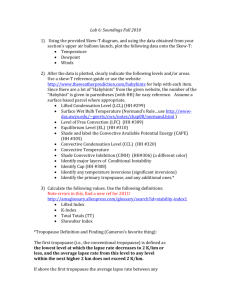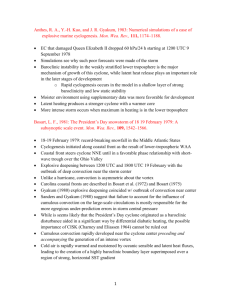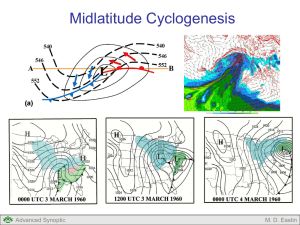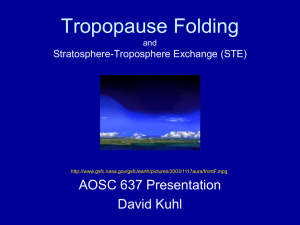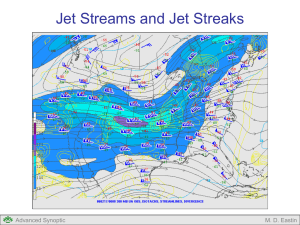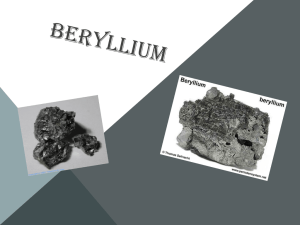Rapid cyclogenesis (bombs)
advertisement
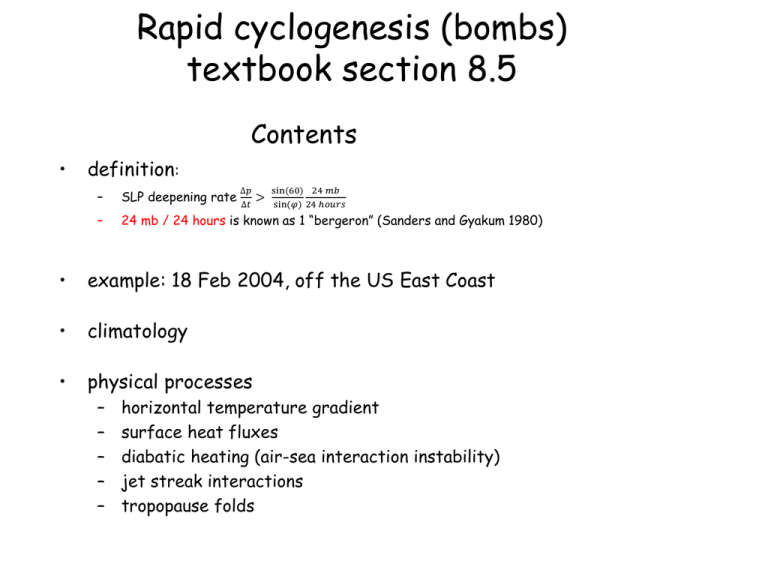
Rapid cyclogenesis (bombs) textbook section 8.5 Contents • definition: ∆𝑝 ∆𝑡 sin(60) 24 𝑚𝑏 sin(𝜑) 24 ℎ𝑜𝑢𝑟𝑠 – SLP deepening rate – 24 mb / 24 hours is known as 1 “bergeron” (Sanders and Gyakum 1980) > • example: 18 Feb 2004, off the US East Coast • climatology • physical processes – – – – – horizontal temperature gradient surface heat fluxes diabatic heating (air-sea interaction instability) jet streak interactions tropopause folds H 1018 1008 992 970 rapid cyclogenesis climatology most common - in winter - off east coasts Gulfstream axis Atlantic Pacific Labrador current Gulf Stream Rapid cyclogenesis mechanisms: near-surface processes • 1. Baroclinicity – large SST gradient and land-sea contrast – strong thermal wind – strong omega ‘forcing’ • Even weak cross-isotherm winds produce large LL temperature advection • LL cyclonic flow readily alters thickness field and amplifies UL trof/ridge large PVA • • 2. Surface sensible heat flux reduces the low-level static stability 3. Surface latent heat flux fuels the storm: Rapid cyclogenesis mechanisms, cont’d • Bombs are primarily baroclinic destabilizations, yet some intensification may occur through a barotropic process, air-sea interaction instability (Emanuel 1986) more BL water vapor (a) low pressure implies surface wind larger sfc LH flux (b) low pressure implies z >0 in friction layer Ekman pumping and LL convergence more LH release in updraft stronger updraft cyclogenesis spin-up (z) Rapid cyclogenesis mechanisms aloft: QG argument • Large low-level water vapor content implies diabatic heating (typically peaking between 850-700 mb) 2 fo 1 k [abs _ vort _ adv] 2 [thermal_ adv] 2 J s p s sp – local max in J (diabatic heating) makes the last term positive stronger updraft – also, the static stability parameter s tends to be small in the warm sector over warm water s o d ln o dp Horizontal temperature gradient 3 different values of stability parameter dash – high s solid – medium s dot – low s surface deepening rate (mb/hr) wavelength From: Sanders 1971 rapid cyclogenesis (anywhere) may also be driven by upper-tropospheric processes (a) Strong coupled jet-front circulation systems – superposition of two upper-level jet streak ascent regions. The interaction is between • a thermally-direct circulation located within the entrance region of a downstream jet streak • and a thermally-indirect circulation in the exit region of an upstream jet streak • This interaction not only enhances omega, but also contributes to differential moisture and temperature advections, and establish an environment within which BL processes specific to the East Coast region (e.g., cold-air damming, coastal frontogenesis, the development of a low-level jet) can further contribute to cyclogenesis and snowstorms. (Uccellini and Kocin 1987) rapid cyclogenesis (anywhere) may also be driven by upper-tropospheric processes (b) Strong WAA aloft due to tropopause depression (or ‘fold’) may cause rapid cyclogenesis in some cases (hydrostatic lowering of SLP) Tropopause folds and ‘occlusions’ p g z RT dz d ln p g z1000 R ztop g 1000 Td ln p ptop note: d ln p ~ dz z1000 R ztop t gH developing (H: scale height = RT/g) H top T t dz sfc Surface height falls (cyclogenesis) relates to warming in the column aloft, with all layers of equal depth weighted equally. Tropopause depressions always occur in the mature stages of cyclogenesis in the UL trof, causing the surface L to ‘move’ into the cold air. Tropopause folds below 500 mb are rare and may contribute to rapid cyclogenesis. mature Hirshberg and Fritsch (1991) Example of a “normal” tropopause depression color fill: potential vorticity (0.1 PV units, i.e. 10-7 m2 s-1 K kg-1) 12 March 1993: storm of the 20th century: impressive tropopause fold @ dynamic tropopause (1.5 PVU) and wind pressure SLP, 850 PV, and 850 e 450 00 Z 12 March 150 1009 150 400 00 Z 13 March 998 150 Rapid cyclogenesis 00 Z 14 March 750 (from Bosart in Shapiro and Gronas 1999) 150 972 References • • • • • • • Emanuel, K.A., 1986: An Air-Sea Interaction Theory for Tropical Cyclones. Part I: Steady-State Maintenance. J. Atmos. Sci., 43, 585–605. Hirshberg, P.A., and M.J. Fritsch, 1991a: Tropopause undulations and the development of extratropical cyclones. Part I: Overview and observations from a cyclone event. Mon. Wea. Rev., 119, 496-517. Hirshberg, P.A., and M.J. Fritsch, 1991b: Tropopause undulations and the development of extratropical cyclones. Part II: Diagnostic analysis and conceptual model. Mon. Wea. Rev., 119, 518-550. Sanders, F., 1971: analytic solutions of the nonlinear omega and vorticity equations for a structurally simple model of disturbances in the baroclinic westerlies. Mon. Wea. Rev., 99, 393– 407. Sanders, F., and J.R. Gyakum, 1980: Synoptic-Dynamic Climatology of the “Bomb”. Mon. Wea. Rev., 108, 1589–1606. Uccellini, L.W., D. Keyser, K. F. Brill and C. H. Wash, 1985: The Presidents' Day Cyclone of 18–19 February 1979: Influence of upstream trough amplification and associated tropopause folding on rapid cyclogenesis. Mon. Wea. Rev., 113, 962–988. Uccellini, Louis W., Paul J. Kocin, 1987: The Interaction of Jet Streak Circulations during Heavy Snow Events along the East Coast of the United States. Weather and Forecasting: Vol. 2, No. 4, pp. 289–309.
